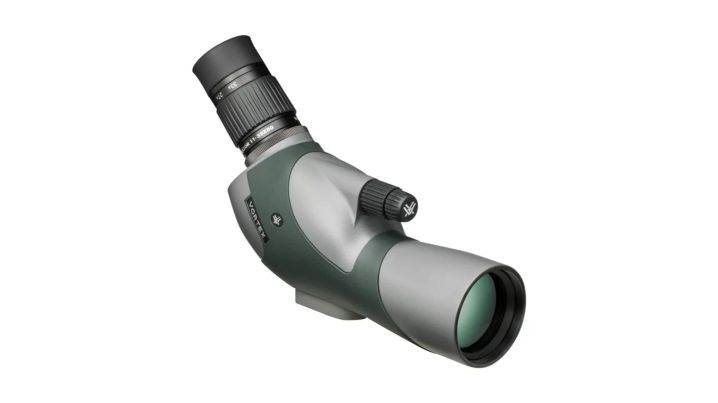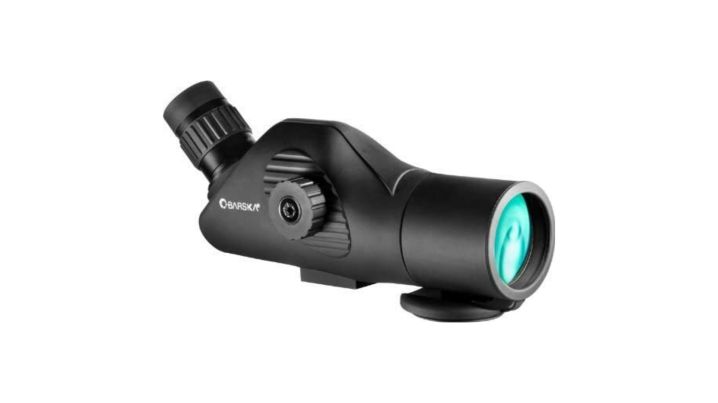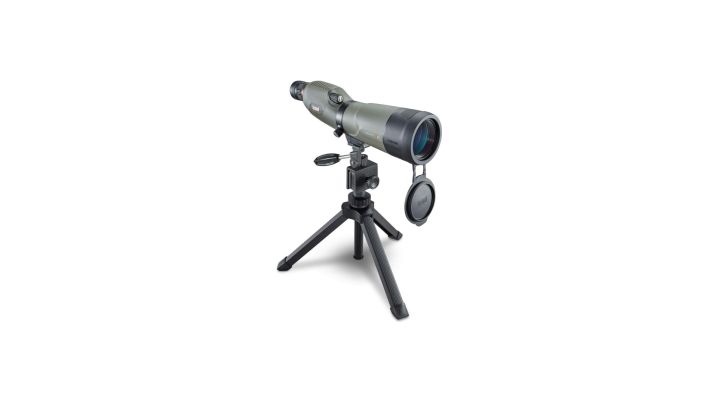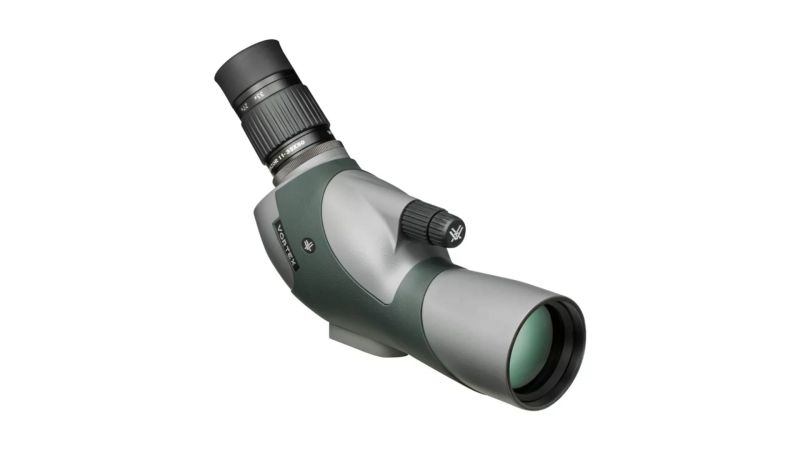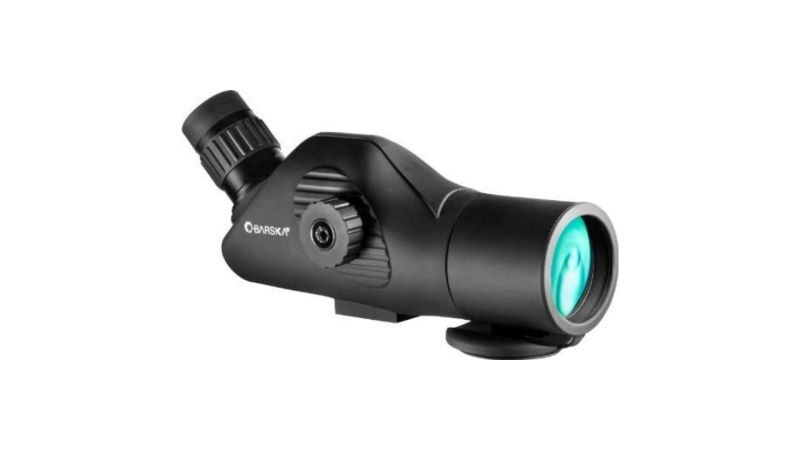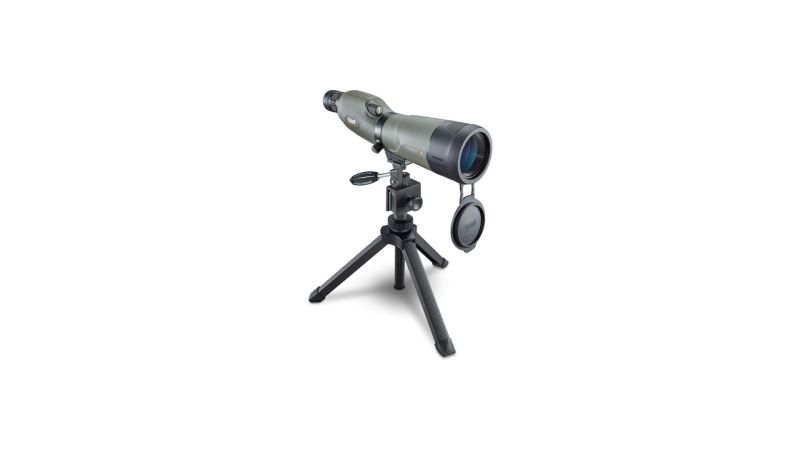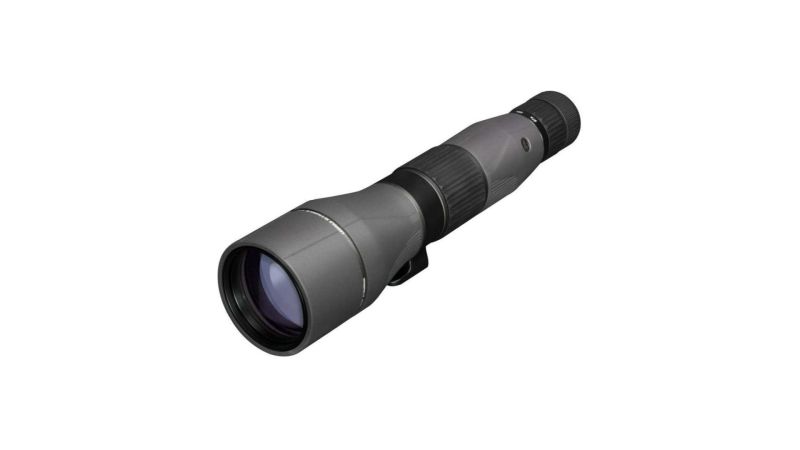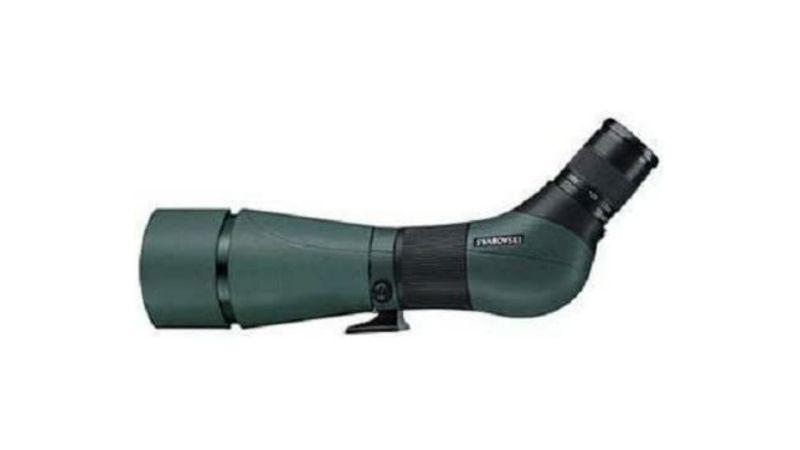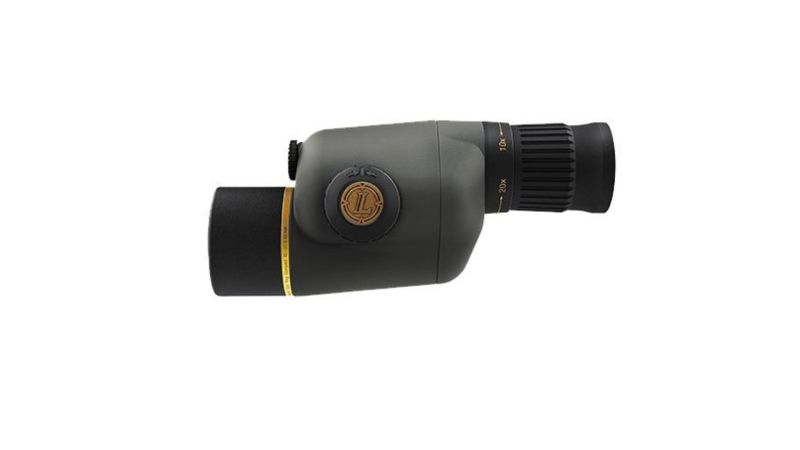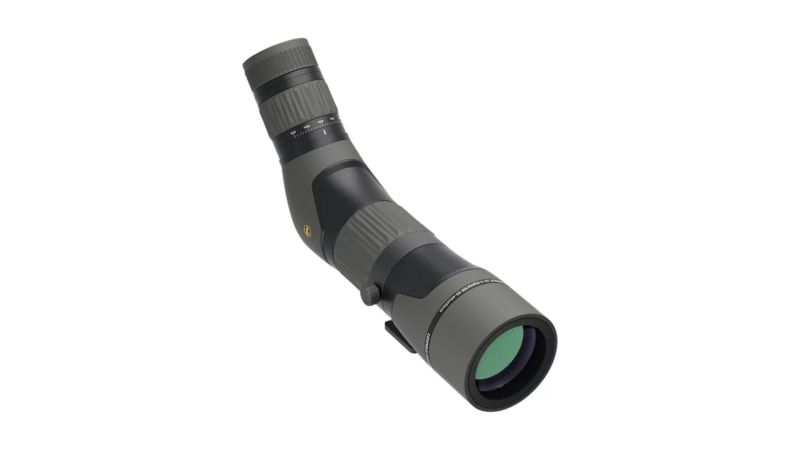We may earn revenue from the products available on this page and participate in affiliate programs.
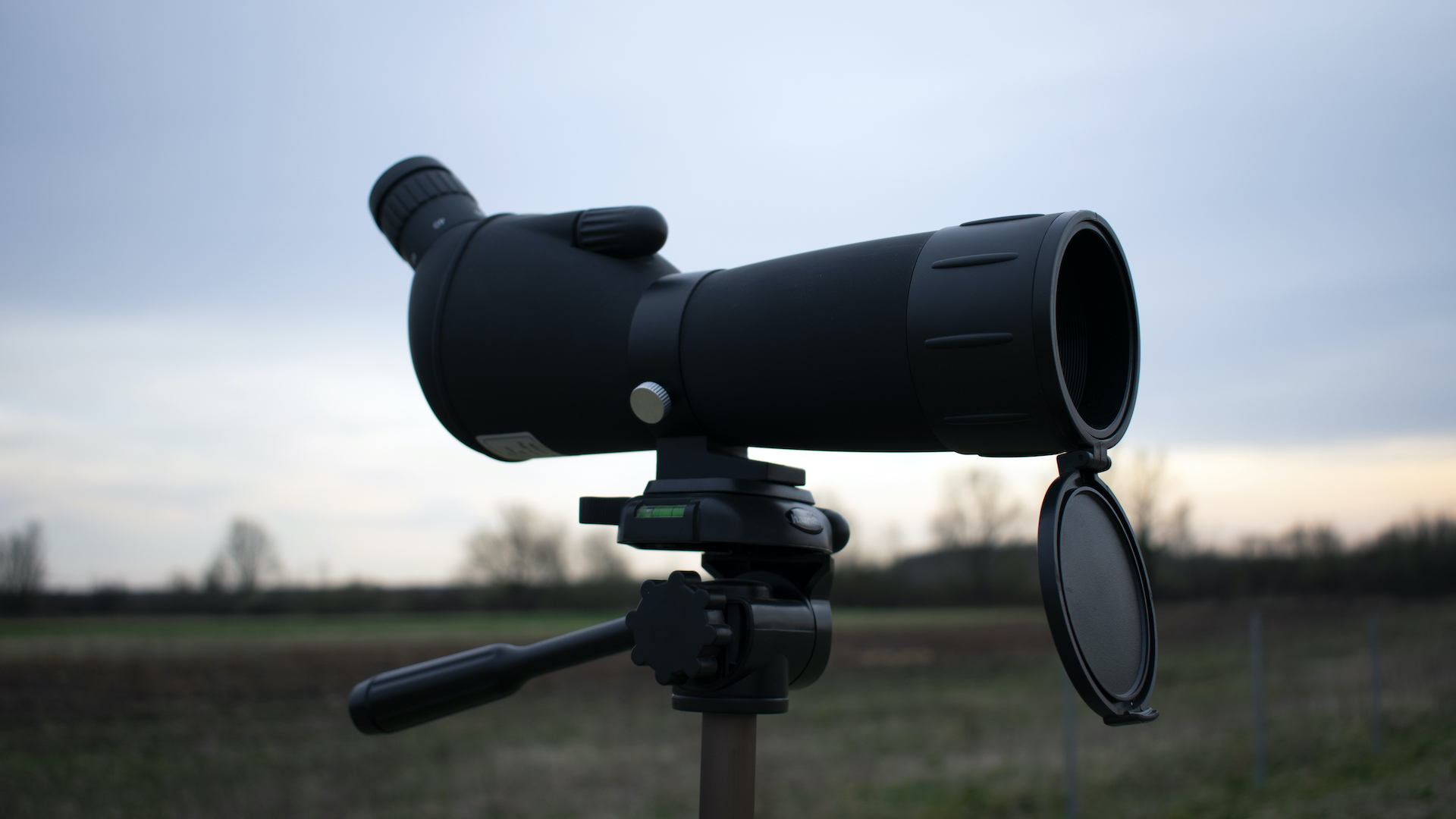
We’ve probably all been guilty of subscribing to the Super Troopers school of shot placement from time to time, but it’s best not to admit that. Whether you’re dialing your hunting rifle before opening day or scanning the horizon for trophy bucks, it’s important to know what you’re shooting at and exactly where your shot will land. That’s where a spotting scope can help.
Spotting scopes offer far more magnification than binoculars or a rifle scope. They’re mounted on tripods so you can get a clear view at tremendous distances. This isn’t just helpful for long-range precision shooters, but it’s also useful for anyone who wants to check their target at the local range without waiting to leave the bench during the next cease-fire.
We rounded up some of the best spotting scopes out there, spanning brands, features, and prices. We also broke down the basics of choosing a spotting scope, so you can put your money to work with something that meets your needs.
- Best Overall: Vortex Razor HD
- Best Value: Barska AD11430
- Editor’s Choice: Bushnell Trophy Xtreme
- Best Straight: Leupold SX-5 Santiam
- Best Angled: Swarovski Optik HD-ATS-80
- Best Compact: Leupold Gold Ring 10-20×40
- Best Weatherproof: Leupold SX-2 Alpine
Best Overall
Vortex Razor HD
Best Value
Barska AD11430
Editor’s Choice
Bushnell Trophy Xtreme
Best Straight
Leupold SX-5 Santiam
Best Angled
Swarovski Optik HD-ATS-80
Best Compact
Leupold Gold Ring 10-20×40
Best Weatherproof
Leupold SX-2 Alpine
Why you should trust us
Your Task & Purpose team is full of writers and gear testers who have made a living shooting for Uncle Sam and working with firearms in the private sector. Whether we’re checking our 100-yard groups or watching 5.56 arc like a rainbow from the 500-yard line, we know how useful a good spotting scope can be. We use all that collective experience to find the best gear possible to recommend to you. When it comes to spotting scopes, we know what it’s like to make do with budget-friendly glass and violate the laws of time and space with high-end optics. Nothing makes this list without earning our vote of confidence.
Types of spotting scopes
Spotting scopes can be categorized by their construction. The way they’re built determines which advantages and disadvantages you’ll be working with, so it’s important to understand what you’re getting into. None of the factors we break down are better or worse than one another, they’re just different. As you do your research, pay attention to whether a spotting scope is straight or angled. Most use unmarked glass, but some feature a reticle that can be used to gauge distances or make shot adjustments.
Straight spotting scopes
Straight spotting scopes look similar to a large rifle scope or a small telescope. Many hunters prefer them because their slim shape is easy to pack. This style also allows fast target acquisition because you can line them up before going to the glass. You can also keep a lower profile, which is good in hunting and tactical situations.
On the downside, they’re awkward to use on an incline (but more comfortable facing downhill). If you’re part of a group that will be sharing the optic, people of different heights will have a harder time getting to eye level with a straight spotting scope.
Angled spotting scopes
Angled spotting scopes are generally shorter end-to-end, but they take up more space than a straight scope. Many people find that bending over an angled eyepiece is easier than getting behind a straight one. A lot of guides attach cameras or digital displays to their spotting scopes, and this type of setup works much better with an angled eyepiece.
The tradeoff to being easier to use on an incline is that angled spotting scopes require serious neck contortions to use on a decline. They can also be cumbersome to use when mounted to a vehicle’s window. You’ll also have to be more mindful of snow and rain accumulating on the eyepiece.
Spotting scopes with a reticle
The vast majority of spotting scopes use an unmarked reticle. They provide an unobstructed view of the target. Some, on the other hand, include a reticle similar to what you’d see on a rifle scope. There are various styles, including MIL and MOA markings. A reticle can be used to estimate range and is especially useful when talking a shooter onto a target.
Having a reticle on your spotting scope seems like a significant advantage, but most people choose not to use one. Finding this kind of scope takes a little bit of digging, and using one effectively requires practice. We were able to track one down for this gear guide (and at a great price, we might add), but most spotting scopes use unmarked lenses to provide a clear view.
Key features of spotting scopes
Magnification
The whole point of using a spotting scope is to see further than you can with other optics. Even rifle scopes and high-powered binoculars can’t compete with a good spotting scope. At the range, rifle optics show you the target, whereas spotting scopes show you the actual hole left by the bullet. In the wild, they allow you to spot game at great distances so you can move in the right direction and know what to expect when you get there.
Some variable-power spotting scopes start as low as 10-power magnification. Most work is done in the 30- to 40-power range. It’s common to see spotting scopes go as high as 60-power magnification. That kind of capability is a game-changer in open landscapes where game animals could be a mile away when you first spot them. At that distance, they’re not even a spec with the naked eye.
Objective lens diameter
The objective lens is the one furthest from your eye on a spotting scope. In optic nomenclature, this is the last number you’ll see. A fixed power optic marked 30×80 will have 30-power magnification and an objective lens size of 80 millimeters in diameter.
Bigger objective lenses let in more light than smaller ones. This usually translates to a clearer picture and a wider field of view. Predictably, the downside to big glass is the space it takes up in your pack. You can also expect to pay more for a larger objective lens, but not always. The quality of glass also plays a factor.
Clarity
If you’re comparing two spotting scopes with similar features but drastically different prices, the cause probably lies in the glass itself. Making durable scope tubes is one thing, but creating material that magnifies images without adding color or distortion is quite difficult. As with diamonds and camera lenses, clarity is a major factor to consider.
Inexpensive spotting scopes can absolutely get the job done while saving you money. They’ll probably include some imperfections, may not provide color that appears true-to-life, and can include distortion (typically around the edge). High-end glass does away with all these distractions, but you’ll have to shell out the big bucks for it.
Benefits of spotting scopes
Target identification
Have you ever spotted a trophy buck for the record books, followed it all day, and then discovered that it’s an undersized adolescent? Or how about that banger of a string of fire that ended up covering the target like chickenpox? It would sure be nice to see what’s going on from the beginning. That’s where a spotting scope comes in handy.
Rifle optics and binoculars are fine for locating targets and game animals, but they don’t do a great job of conveying the finer details. If you think the view through a 10-power rifle scope is good, try a 60-power spotting scope for a change in perspective. Boosting your vision will allow you to more effectively engage all targets.
Shot adjustments
Whether you’re working as a team or on your own, seeing exactly where your shots land makes a huge difference. I’d much rather be told to hold two inches left than hear that I’m “like, a little bit to the right, probably.” The difference is in how much magnification you have at your disposal. In fact, if you set up correctly at a long enough range, you can even watch bullets fly toward the target.
This is helpful during long-distance precision shooting, but it’s just as useful when you’re sighting in a new optic. Rather than running back and forth to check your last group, you can check as you go and dial-up adjustments in no time.
Efficient use of time
Time is money, folks. You pay for range time with cash and you pay for hunting trips with PTO, so make your investment count. That means spending more of it taking care of business and less of it wandering around trying to get a better view of things.
At the range, spotting scopes cut down on downtime because you don’t need a cease-fire to check your shot placement. In the field, you can determine if that thing in the distance is the animal you’re after or a rock. If you have enough space, you can call in game animals and adjust your position as they approach from any direction.
Pricing considerations for spotting scopes
Budget
Entry-level spotting scopes can be had for less than $200. Most are from smaller manufacturers with less-established reputations, but there are a few options from the bigger brands.
These basic scopes are fine for range duty because most shooters don’t reach beyond about 200 yards. At that distance, these spotting scopes will give you a solid understanding of your shot placement without emptying your wallet.
As distances increase, cost-cutting measures start to become more apparent. These entry-level spotting scopes may not offer the level of magnification you need. You’ll probably notice slight color variation and distortion as a result of the inexpensive glass. There may even be small imperfections that clutter your view. These drawbacks might not bother you, in which case there’s no reason you can’t save a bundle.
Mid-range
Many spotting scopes cost somewhere between $200 and $500. At this level, you’ll find quality options from just about all the major manufacturers and get a versatile optic that can do what you need it to do.
By stepping up to this price range, you’ll get access to better materials in the lenses, tube, and eyecups. Straight and angled spotting scopes offer nice variety so you can find what works best for you. The same goes for tripods and window mounts. The image you see will be noticeably better than what you’d get from a budget spotting scope.
On the downside, there’s still a big difference between these everyday spotting scopes and their top-of-the-line alternatives. In some cases, you might not be able to justify the hefty jump in price, though. These tend to be great options for people who need their gear to perform but don’t baby it.
Premium
Premium spotting scopes cost well beyond $500. It’s not uncommon to see them going for $2,000, and we found a few that are pushing $4,000. That’s a massive increase over what most shooters pay, but the quality is undeniable.
The prices of these spotting scopes reflect the cost to build them. Not only do they use much higher-quality glass, but they’re also built with metal that is both light and strong. Image quality is excellent and natural in appearance.
Sadly, this level of build quality puts top-tier spotting scopes out of range for most people. In most cases, they’re also unnecessary. If you do a lot of long-range precision shooting or big hunting trips out west, though, we encourage you to consider stepping up to this kind of gear because the difference is undeniable.
How we chose our top picks
For this gear guide, we tried to account for the different things people need their spotting scopes to accomplish. Some shooters just need to check paper targets from 50- to 100-yards out. There’s no need for them to blow the budget when a basic spotting scope will do. Others need the very best for their backcountry hunting trips. We accounted for everyone with a variety of spotting scopes that––regardless of their price and features––we’d be comfortable using for the intended purpose.
FAQs on spotting scopes
You’ve got questions, Task & Purpose has answers.
Q. What is a spotting scope used for?
A: Spotting scopes are used to see accurately at great distances. Hunters and wildlife tour guides use them to observe and identify animals without disturbing them. At the range, spotting scopes allow shooters to evaluate their shot placement without leaving the bench.
Q. Can you use a telescope as a spotting scope?
A: It’s possible, but we wouldn’t recommend it. Telescopes tend to be much larger and more fragile than a spotting scope.
Q. Can I attach a camera to my spotting scope?
A: Yes, and that’s a great way to get the most out of it. Wildlife guides and hunters both use this technique to take pictures of the animals they see. You might be surprised by how well the pictures turn out.
Q. What makes a spotting scope good for hunting?
A: Spotting scopes allow hunters to see far beyond what’s possible with the naked eye, binoculars, or a rifle scope. They allow much better target identification and can scan distant terrain much more effectively than less-powerful optics.
Q. How should I carry my spotting scope?
A: Spotting scopes are built for hunters who will be carrying them across rugged terrain in all kinds of weather. That being said, they’re still precision optics and it’s a good idea to take care of them with a padded case when possible.
Q. What do the numbers on a spotting scope mean?
A: Numbers before the X indicate the fixed or telescopic range of magnification. The number after the X indicates the objective lens size in millimeters. A scope labeled 10-20×40 can zoom between 10- and 20-power magnification and has an objective lens that’s 40 millimeters in diameter.
Q. What magnifications are typical for spotting scopes?
A: Most spotting is probably done between 30- and 40-power magnification. Plenty of spotting scopes reach far beyond that, and there are times when that’s useful. People in wide-open landscapes with clear, calm air can certainly take advantage of more powerful optics.
